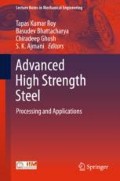Abstract
The challenge to develop new steel grades with superior mechanical properties in terms of yield strength and deformation behavior has to take into consideration technical, processing, marketing, and economic aspects. The environmental impact in regard to a life cycle assessment is already for AHSS grades very favorable as less material has to be produced and processed on one hand coupled with substantial lower weight to logistically be handled. The technical challenges during production and processing cover the complete process chain from steelmaking, casting, rolling, coating, and annealing.
AHSS steel grades are characterized by complex alloying concepts with increased Al and Mn contents; the grades show the tendency for crack formation during solidification. High-strength and strong deformation force leads to high loads and torques in the rolling mills. The superior mechanical properties in regard to elongation and yield strength are derived by complex microstructure engineering with dedicated or accelerated cooling patterns. Therefore, a comprehensive review of the complete process chain is required to identify obstacles and bottlenecks.
The paper gives insights how to overcome the challenges and shortcomings during the production and processing of these grades. The already developed solutions as
-
adopted caster design and adjusted cooling,
-
belt casting technology for the production of HSD-TWIP grades,
-
accelerated cooling technologies in hot rolling, and
-
I-Furnace solution for Q + P grades
are described in this paper.
Finally, an indispensable prerequisite for production of AHSS grades is strict conformance to process and quality management through the entire process chain, which demands a powerful tool to monitor, document, analyze, and secure the operation. A PQA quality management solution including an expert-based know-how software kernel can respond in time to ensure highest yield at optimum quality for utmost customer satisfaction.
Access this chapter
Tax calculation will be finalised at checkout
Purchases are for personal use only
References
M.Y. Demiri, Advanced High-Strength Steels—Science, Technology, and Applications, ASM International, (2013)
SMS—Group corporate information: www.sms-group.com/plants/all-plants/belt-casting-technology/concepts/
Ch. Hassel, A. Sprock and S. Krämer, The influence of an enhanced runout table cooling on the microstructure, mechanical properties andalloy savings: AISTech 2016, Pittsburgh, PA, USA.
H. Behrens, F. Brühl, L. Kümmel, C. Sasse and J.P. Crutzen, Conditions for galvanizing modern automotive steel grades, 108th Galvanizers Association Conference, Farmington PA, USA, (2016)
J. Kempken, M. Reifferscheid, et al., Integrated Product Improvement by Quality Analysis and Modeling, European Continuous Casting Conference – ECCC, Nizza 2005.
J. Kempken and T. Hüper, State of the Art Product Quality Management—Operational Success with State of the Art Product Quality Analysis (PQA) Solutions, ABM Conference Proceedings, Rio de Janeiro, (2016)
J. Kempken and T. Hüper, PQA—The Success Factor to reach next Performance Level in Hot and Cold Rolling, AISTec Conf., Nashville, (2017)
Author information
Authors and Affiliations
Corresponding author
Editor information
Editors and Affiliations
Rights and permissions
Copyright information
© 2018 Springer Nature Singapore Pte Ltd.
About this chapter
Cite this chapter
Kempken, J. (2018). Technological Challenges and Solutions for the Production of State-of-the-Art Second- and Third-Generation AHSS Grades. In: Roy, T., Bhattacharya, B., Ghosh, C., Ajmani, S. (eds) Advanced High Strength Steel. Lecture Notes in Mechanical Engineering. Springer, Singapore. https://doi.org/10.1007/978-981-10-7892-7_16
Download citation
DOI: https://doi.org/10.1007/978-981-10-7892-7_16
Published:
Publisher Name: Springer, Singapore
Print ISBN: 978-981-10-7891-0
Online ISBN: 978-981-10-7892-7
eBook Packages: EngineeringEngineering (R0)

